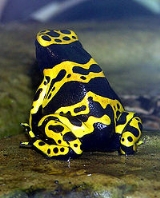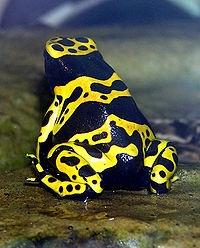
Indio Maíz Biological Reserve
Encyclopedia
Indio Maíz Biological Reserve measures about 4,500 square kilometers and is situated on the southeastern corner of Nicaragua
bordering the San Juan River
. It is the second largest expanse of lowland rainforest
reserve in Nicaragua and is referred to as "the gem of Central America
n nature reserves" by UCLA biologist
s. Indio Maíz is rich in biodiversity
, it holds a higher number in species of trees, birds, and insects than all of Europe
. It is also noted as a popular protected area
for tourists.
 The Indio Maíz Biological Reserve was established as a protected area
The Indio Maíz Biological Reserve was established as a protected area
in the 1990s, after Bosawas. Indio Maiz boasts a large number in species of both flora
and fauna
. It is estimated to be home to over 400 species of birds, 200 species of reptiles and 4 species of wild cat
s.
Some of the mammals present include pumas, jaguar
s, armadillo
s, sloth
s, raccoon
s, wild boar and the incredible tame manatee
s and many other unusual animals. Also present are several different species of monkey, most notably the White-headed Capuchin
which is classified as extinct, along with howler
and spider monkeys.
Among the reptile family, brightly colored poison dart frog
s, iguana
s, snake
s, royal tarpon
s are common. The world's only freshwater shark, Nicaragua shark
, known elswhere in the world as the Bull Shark or Zambesi Shark is also present in the San Juan River which borders the reserve. However, Nicaragua has recently banned freshwater fishing of the Nicaragua shark
because of population declines.
Nicaragua
Nicaragua is the largest country in the Central American American isthmus, bordered by Honduras to the north and Costa Rica to the south. The country is situated between 11 and 14 degrees north of the Equator in the Northern Hemisphere, which places it entirely within the tropics. The Pacific Ocean...
bordering the San Juan River
San Juan River (Nicaragua)
The San Juan River , also known as El Desaguadero , is a 192.06 km river that flows east out of Lake Nicaragua into the Caribbean Sea. A large section of the border between Nicaragua and Costa Rica runs on the right bank of the river...
. It is the second largest expanse of lowland rainforest
Rainforest
Rainforests are forests characterized by high rainfall, with definitions based on a minimum normal annual rainfall of 1750-2000 mm...
reserve in Nicaragua and is referred to as "the gem of Central America
Central America
Central America is the central geographic region of the Americas. It is the southernmost, isthmian portion of the North American continent, which connects with South America on the southeast. When considered part of the unified continental model, it is considered a subcontinent...
n nature reserves" by UCLA biologist
Biologist
A biologist is a scientist devoted to and producing results in biology through the study of life. Typically biologists study organisms and their relationship to their environment. Biologists involved in basic research attempt to discover underlying mechanisms that govern how organisms work...
s. Indio Maíz is rich in biodiversity
Biodiversity
Biodiversity is the degree of variation of life forms within a given ecosystem, biome, or an entire planet. Biodiversity is a measure of the health of ecosystems. Biodiversity is in part a function of climate. In terrestrial habitats, tropical regions are typically rich whereas polar regions...
, it holds a higher number in species of trees, birds, and insects than all of Europe
Europe
Europe is, by convention, one of the world's seven continents. Comprising the westernmost peninsula of Eurasia, Europe is generally 'divided' from Asia to its east by the watershed divides of the Ural and Caucasus Mountains, the Ural River, the Caspian and Black Seas, and the waterways connecting...
. It is also noted as a popular protected area
Protected area
Protected areas are locations which receive protection because of their recognised natural, ecological and/or cultural values. There are several kinds of protected areas, which vary by level of protection depending on the enabling laws of each country or the regulations of the international...
for tourists.
Overview

Protected area
Protected areas are locations which receive protection because of their recognised natural, ecological and/or cultural values. There are several kinds of protected areas, which vary by level of protection depending on the enabling laws of each country or the regulations of the international...
in the 1990s, after Bosawas. Indio Maiz boasts a large number in species of both flora
Flora
Flora is the plant life occurring in a particular region or time, generally the naturally occurring or indigenous—native plant life. The corresponding term for animals is fauna.-Etymology:...
and fauna
Fauna
Fauna or faunæ is all of the animal life of any particular region or time. The corresponding term for plants is flora.Zoologists and paleontologists use fauna to refer to a typical collection of animals found in a specific time or place, e.g. the "Sonoran Desert fauna" or the "Burgess shale fauna"...
. It is estimated to be home to over 400 species of birds, 200 species of reptiles and 4 species of wild cat
Wild cat
The wildcat is a small cat with several subspecies and a very broad distribution, found throughout most of Africa, Europe, and southwest and central Asia into India, China, and Mongolia. It is a hunter of small mammals, birds, and other creatures of a similar or smaller size. Sometimes included is...
s.
Some of the mammals present include pumas, jaguar
Jaguar
The jaguar is a big cat, a feline in the Panthera genus, and is the only Panthera species found in the Americas. The jaguar is the third-largest feline after the tiger and the lion, and the largest in the Western Hemisphere. The jaguar's present range extends from Southern United States and Mexico...
s, armadillo
Armadillo
Armadillos are New World placental mammals, known for having a leathery armor shell. Dasypodidae is the only surviving family in the order Cingulata, part of the superorder Xenarthra along with the anteaters and sloths. The word armadillo is Spanish for "little armored one"...
s, sloth
Sloth
Sloths are the six species of medium-sized mammals belonging to the families Megalonychidae and Bradypodidae , part of the order Pilosa and therefore related to armadillos and anteaters, which sport a similar set of specialized claws.They are arboreal residents of the jungles of Central and South...
s, raccoon
Raccoon
Procyon is a genus of nocturnal mammals, comprising three species commonly known as raccoons, in the family Procyonidae. The most familiar species, the common raccoon , is often known simply as "the" raccoon, as the two other raccoon species in the genus are native only to the tropics and are...
s, wild boar and the incredible tame manatee
Manatee
Manatees are large, fully aquatic, mostly herbivorous marine mammals sometimes known as sea cows...
s and many other unusual animals. Also present are several different species of monkey, most notably the White-headed Capuchin
White-headed Capuchin
The white-headed capuchin , also known as the white-faced capuchin or white-throated capuchin, is a medium-sized New World monkey of the family Cebidae, subfamily Cebinae...
which is classified as extinct, along with howler
Howler monkey
Howler monkeys are among the largest of the New World monkeys. Fifteen species are currently recognised. Previously classified in the family Cebidae, they are now placed in the family Atelidae. These monkeys are native to South and Central American forests...
and spider monkeys.
Among the reptile family, brightly colored poison dart frog
Poison dart frog
Poison dart frog is the common name of a group of frogs in the family Dendrobatidae which are native to Central and South America. These species are diurnal and often have brightly-colored bodies...
s, iguana
Iguana
Iguana is a herbivorous genus of lizard native to tropical areas of Central America and the Caribbean. The genus was first described in 1768 by Austrian naturalist Josephus Nicolaus Laurenti in his book Specimen Medicum, Exhibens Synopsin Reptilium Emendatam cum Experimentis circa Venena...
s, snake
Snake
Snakes are elongate, legless, carnivorous reptiles of the suborder Serpentes that can be distinguished from legless lizards by their lack of eyelids and external ears. Like all squamates, snakes are ectothermic, amniote vertebrates covered in overlapping scales...
s, royal tarpon
Tarpon
Tarpons are large fish of the genus Megalops. There are two species of Megalops, one native to the Atlantic, and the other to the Indo-Pacific oceans.They are the only members of the family Megalopidae.- Species and habitats :...
s are common. The world's only freshwater shark, Nicaragua shark
Bull shark
The bull shark, Carcharhinus leucas, also known as Zambezi shark or unofficially known as Zambi in Africa and Nicaragua shark in Nicaragua, is a shark common worldwide in warm, shallow waters along coasts and in rivers...
, known elswhere in the world as the Bull Shark or Zambesi Shark is also present in the San Juan River which borders the reserve. However, Nicaragua has recently banned freshwater fishing of the Nicaragua shark
Bull shark
The bull shark, Carcharhinus leucas, also known as Zambezi shark or unofficially known as Zambi in Africa and Nicaragua shark in Nicaragua, is a shark common worldwide in warm, shallow waters along coasts and in rivers...
because of population declines.
See also
- Wildlife of NicaraguaWildlife of NicaraguaThe fauna of Nicaragua is characterized by a very high level of biodiversity. Much of Nicaragua's wildlife lives in protected areas. There are currently 78 protected areas in Nicaragua, covering more than , or about 17% of its landmass. These protected areas encompass a wide variety of habitats,...
- Tourism in NicaraguaTourism in NicaraguaTourism in Nicaragua has grown considerably recently, and it is now the second largest industry in the nation. Nicaraguan President Daniel Ortega has stated his intention to use tourism to combat poverty throughout the country. The growth in tourism has positively affected the agricultural,...
- Protected areas of Nicaragua
External links
- ViaNica.com Indio Maíz Biological Reserve

